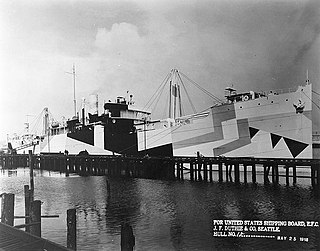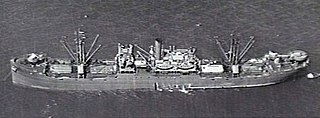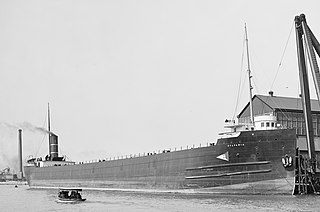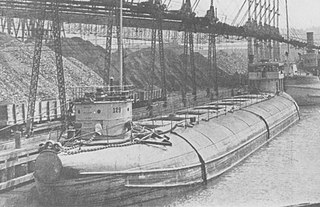Related Research Articles
The Pere Marquette Railway operated in the Great Lakes region of the United States and southern parts of Ontario in Canada. It had trackage in the states of Michigan, Ohio, Indiana and the Canadian province of Ontario. Its primary connections included Buffalo; Toledo; and Chicago. The company was named after Père Jacques Marquette S.J. (1637–1675), a French Jesuit missionary who founded Michigan's first European settlement, Sault Ste Marie.
The SS Anna C. Minch was a cargo carrier which foundered, broke in two, and sank in Lake Michigan during the Armistice Day Blizzard on 11 November 1940. The Anna C. Minch was a steam-powered, steel-hulled bulk freighter constructed in 1903 by the American Ship Building Company at Cleveland, Ohio.

The Great Lakes Engineering Works (GLEW) was a leading shipbuilding company with a shipyard in Ecorse, Michigan, that operated between 1902 and 1960. Within three years of its formation, it was building fifty percent of the tonnage of all ships in the Great Lakes. During World War II, GLEW was commissioned by Pittsburgh Steamship Company and the U.S. Maritime Commission to build twenty-one ore freighters. Its innovations included the first self-unloader freighter, SS Wyandotte. GLEW is best known for its construction of the SS Edmund Fitzgerald.

J. F. Duthie & Company was a small shipyard in Seattle, Washington. It was organized in 1911 and expanded in World War I to build cargo ships for the United States Shipping Board (USSB).

The Columbia River Shipbuilding Company was a small shipyard in Portland, Oregon, United States, located on the west bank of the Willamette River. The shipyard was located at the foot of SW Sheridan Street, just upstream of the Interstate 5 Marquam Bridge.

SS Lake Arthur (ID-2915) was a Design 1020 cargo ship that served in the Naval Overseas Transportation Service (NOTS) of the United States Navy during World War I. Originally ordered and begun under the name SS War Plum, she was renamed SS Lake Arthur by the United States Shipping Board (USSB). After her naval service, she operated commercially under a variety of names, before being scuttled in the North Sea with a load of chemical weapons in November 1945.
General Engineering & Dry Dock Company was a shipbuilding company in Alameda, California that was active from the 1920s through the 1940s. The company built ships for the Southern Pacific Railroad and the United States Coast Guard in the late 1920s and early 1930s.

MV Paul R. Tregurtha is a Great Lakes-based bulk carrier freighter. She is the current Queen of the Lakes, an unofficial but widely-recognized title given to the longest vessel active on the Great Lakes. Launched as William J. De Lancey, she was the last of the 13 "thousand footers" to enter service on the Great Lakes, and was also the last Great Lakes vessel built at the American Ship Building Company yard in Lorain, Ohio.
The American Ship Building Company was the dominant shipbuilder on the Great Lakes before the Second World War. It started as Cleveland Shipbuilding in Cleveland, Ohio in 1888 and opened the yard in Lorain, Ohio in 1898. It changed its name to the American Ship Building Company in 1900, when it acquired Superior Shipbuilding, in Superior, Wisconsin; Toledo Shipbuilding, in Toledo, Ohio; and West Bay Shipbuilding, in West Bay City, Michigan. With the coming of World War I, the company also acquired Buffalo Dry Dock, in Buffalo, New York; Chicago Shipbuilding, in Chicago, Illinois; and Detroit Shipbuilding, in Wyandotte, Michigan. American Shipbuilding ranked 81st among United States corporations in the value of World War II military production contracts.

M/V Walter J. McCarthy Jr. is a very large diesel-powered lake freighter owned and operated by the American Steamship Company. This vessel was built in 1977 at Bay Shipbuilding Company, Sturgeon Bay, Wisconsin and included self-unloading technology.

MV Roger Blough is a ship built in 1972 by American Ship Building Company in Lorain, Ohio. She serves as a lake freighter on the Great Lakes. The ship is owned by Great Lakes Fleet, Inc. and is named for the former chairman of U.S. Steel, Roger Blough.
District 9 is a United States Coast Guard district located at the Anthony J. Celebrezze Federal Building in Cleveland, Ohio. District 9 is responsible for all Coast Guard operations on the five Great Lakes, the Saint Lawrence Seaway, and surrounding states accumulating 6,700 miles of shoreline and 1,500 miles of international shoreline with Canada.

The SS Sylvania was a 572-foot (174 m) Great Lakes freighter that had a long 79-year career on the Great Lakes. Sylvania was built by the West Bay City Shipbuilding Company of West Bay City, Michigan as hull #613. She was built for the Duluth Steamship Company of Duluth, Minnesota.

Howard L. Shaw was a 451-foot (137 m) long propeller driven freighter that operated on the Great Lakes of North America from her launching in 1900 to her retirement 1969. She is currently serving as a breakwater in Ontario Place on Lake Ontario.

SS Onoko was an iron hulled Great Lakes freighter. She was launched in 1882 in Cleveland, Ohio as hull number #4, and sank on September 14, 1915 in Lake Superior near Knife River, Minnesota. Onoko is thought to be the prototype for every single steel hulled Great Lakes Bulk carrier that ever sailed. These vessels made possible the cheap transport of bulk cargoes such as iron ore, coal and limestone. Her wreckage still remains on the bottom of Lake Superior and was listed on the National Register of Historic Places in 1992.

The McDougall Duluth Shipbuilding Company was a large-scale wartime ship manufacturing shipyard, located at the city of Riverside, near Duluth. McDougall Duluth Shipbuilding was at 110 Spring Street, Duluth, Minnesota, now the site of the West Duluth's Spirit Lake Marina. The shipyard was located on St. Louis River Estuary at western part of Lake Superior. McDougall Duluth Shipbuilding Company was found by Alexander McDougall (1845-1923) in 1917 to built ships for World War I. McDougall Duluth Shipbuilding Company and the Superior Shipbuilding Company were called the Twin Ports shipbuilding industry of Minnesota and Wisconsin. Once built the ships can travel to the Atlantic Ocean through the Great Lakes and the Saint Lawrence Seaway.

Walter Butler Shipbuilders Inc. was a large-scale World War II ship manufacturing shipyard, located at Superior, Wisconsin. Walter Butler purchased the shipyard from Lake Superior Shipbuilding in 1942. Walter Butler Shipbuilders Inc. was at E 1st St, Superior, Wisconsin. The shipyard was located on the western part of Lake Superior. Walter Butler Shipbuilders Inc. was found by Walter Butler in 1942 to built ships for World War II. Walter Butler Shipbuilders Inc., the McDougall Duluth Shipbuilding Company and the Superior Shipbuilding Company were called the Twin Ports shipbuilding industry of Minnesota and Wisconsin. Once built the ships can travel to the Atlantic Ocean through the Great Lakes and the Saint Lawrence Seaway.

129 was an American whaleback barge in service between 1893 and 1902. Built between December 1892 and May 1893, in Superior, Wisconsin,, by Alexander McDougall's American Steel Barge Company, for McDougall's fleet of the same name, based in Buffalo, New York. She was one of a class of distinctive and experimental class of ships designed and built by McDougall. The whalebacks were designed to be more stable in high seas. They had rounded decks, and lacked the normal straight sides seen on traditional lake freighters. 129 entered service on May 22, hauling wheat from Superior. She was sold to the Bessemer Steamship Company of Cleveland, Ohio, in 1900. In 1901, she became owned by the Pittsburgh Steamship Company of Duluth, Minnesota, when the Bessemer fleet merged into it.

Craig Shipbuilding was a shipbuilding company in Long Beach, California. To support the World War 1 demand for ships Craig Shipbuilding shipyard switched over to military construction and built: US Navy Submarines and Cargo Ships. Craig Shipbuilding was started in 1906 by John F. Craig. John F. Craig had worked in Toledo, Ohio with his father, John Craig (1838-1934), and Blythe Craig, both shipbuilders, their first ship was built in 1864 at Craig Shipbuilding Toledo. John F. Craig opened his shipbuilding company in Port of Long Beach on the south side of Channel 3, the current location of Pier 41 in the inner harbor, becoming the port's first shipyard. In 1907 Craig Shipbuilding is given a contract to dredge a channel from the Pacific ocean to the inner harbor. In 1917 Craig sold the shipyard to the California Shipbuilding Company. But then opened a new shipyard next to the one he just sold and called it the Long Beach Shipbuilding Company. The Long Beach Shipbuilding Company built cargo ships in 1918, 1919, and 1920 for the United States Shipping Board.

104 was an American whaleback barge in service between 1890 and 1898. The fourth whaleback constructed, she was built between October 1889 and February 1890, in Duluth, Minnesota by Alexander McDougall's American Steel Barge Company, for McDougall's fleet of the same name, based in Buffalo, New York. She was a whaleback, a class of distinctive, experimental ship designed and built by McDougall. The whalebacks were designed to be more stable in high seas. They had rounded decks, and lacked the normal straight sides seen on traditional lake freighters. 104 entered service on April 21, hauling iron ore from Two Harbors, Minnesota.
References
- 1 2 3 4 5 McKellar, p. Part II, 581–584.
- ↑ Colton, Tim (15 August 2015). "Globe Iron Works, Cleveland OH (later AmShip Cleveland)". shipbuildinghistory.com. Retrieved 4 April 2021.
- ↑ Colton, Tim (August 25, 2015). "American Shipbuilding Lorain, Lorain OH (formerly Cleveland Shipbuilding [1886-1897 in Cleveland, 1897-1900 in Lorain])". shipbuildinghistory.com. Retrieved 4 April 2021.
- ↑ Colton, Tim (19 August 2015). "American Steel Barge, Superior WI (Later Superior Shipbuilding and AmShip Superior)". shipbuildinghistory.com. Retrieved 4 April 2021.
- ↑ Colton, Tim (17 August 2015). "Buffalo Dry Dock, Buffalo NY (formerly Bidwell & Banta [1808-1870], Union Dry Dock Co. [1871-1899], later AmShip Buffalo [1914-1962])". shipbuildinghistory.com. Retrieved 4 April 2021.
- ↑ Colton, Tim (August 17, 2015). "Chicago Shipbuilding, Chicago IL (later AmShip Chicago)". Shipbuilding History. Retrieved 4 April 2021.
- ↑ Colton, Tim (19 August 2015). "Detroit Shipbuilding, Detroit MI and Wyandotte MI (formerly Campbell, Wolverton & Co. [1852-1862], Campbell & Owen [1862-1874], Wyandotte Shipbuilding [1872-1898] and Detroit Dry Dock [1874-1899], later AmShip Detroit [1913-1929])". shipbuildinghistory.com. Retrieved 4 April 2021.
- ↑ Colton, Tim (28 August 2019). "Globe Shipbuilding (WWII), Superior WI". shipbuildinghistory.com. Retrieved 4 April 2021.
- ↑ Colton, Tim (6 July 2013). "Walter Butler Shipbuilders, Duluth MN (formerly McDougall-Duluth Company and Barnes-Duluth Shipbuilding)". shipbuildinghistory.com. Retrieved 4 April 2021.
- ↑ Colton, Tim (9 March 2016). "Saginaw Shipbuilding, Saginaw MI". shipbuildinghistory.com. Retrieved 4 April 2021.
- ↑ Colton, Tim (20 August 2015). "Craig Shipbuilding, Toledo OH (Linn & Craig [1869-1882], J. Craig & Sons [1883-1889], Blythe Craig Shipbuilding [1890-1893], Craig Shipbuilding [1893-1905], Toledo Shipbuilding [1906-1945] and AmShip Toledo [1945-1982])". shipbuildinghistory.com. Retrieved 4 April 2021.